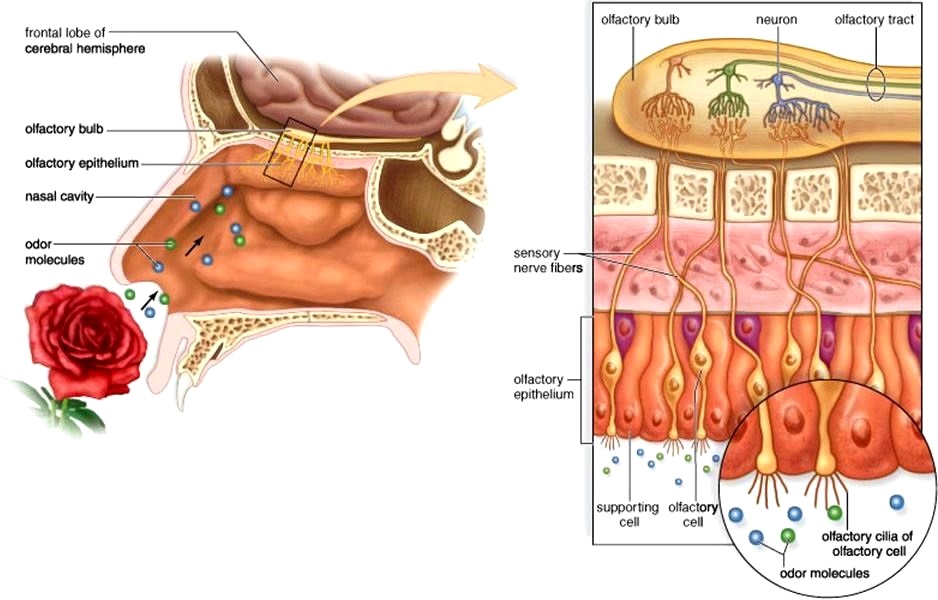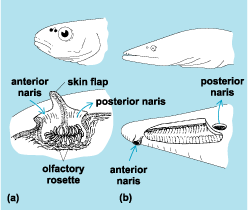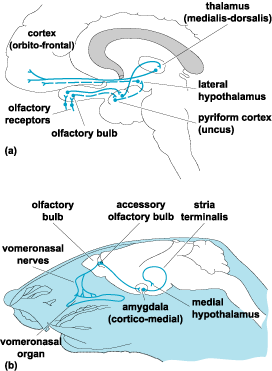Key Concepts
One of the chemical senses, specifically the sense of smell. Olfaction comprises the action or capacity of smelling, and is a form of chemoreception (the ability of organisms to detect changes in the chemical composition of their exterior or interior environment). Olfaction registers chemical information in organisms ranging from insects to humans (Fig. 1), including marine organisms. For terrestrial animals, its stimuli comprise airborne molecules. The typical stimulus is an organic chemical with molecular weight below 300 daltons; about a half million such substances exist. In addition, a few inorganic chemicals can stimulate olfaction, notably hydrogen sulfide, ozone, ammonia, and the halogens. For marine organisms, amino acids and proteins, which derive largely from the decomposition of organic matter, form particularly good stimuli. See also: Chemical ecology; Chemical senses; Chemoreception; Sense organ

Anatomy and physiology
The anatomy of olfactory structures and the neurophysiology of olfaction differ significantly among different animal groups. In all vertebrates, the nose functions primarily as the organ of smell. See also: Neurobiology; Nose
Insects
Insect olfactory receptors exist within sensory hairs on the antennae. Each hair contains thousands of pores in its cuticle. Stimulating molecules must pass through the pores in order to stimulate the outer segment of a receptor cell. This process of transduction has been studied through the measurement of electric potentials from the receptor neurons. The best known potential—the electroantennogram—reflects the action of many receptor neurons. See also: Insect physiology; Insecta; Neuron
Certain insect olfactory receptors are specialists and respond to a very narrow range of relevant chemicals (for example, sex attractants secreted by females, but registered only by males). Generalist receptors, on the other hand, respond to a wide range of chemicals. One generalist cell differs somewhat from another in the variety of materials to which it responds, permitting discrimination of different materials in an across-receptor pattern of induced neural activity.
Fishes
The olfactory organ of fishes resides typically in tubular chambers on either side of the mouth (Fig. 2). As the fish swims, water passes through the chamber and comes into contact with the olfactory epithelium that lines the folds of a structure called the olfactory rosette. This epithelium has great similarity to that of terrestrial vertebrates. In addition to proteins and amino acids, fishes respond to many of the odorants that form the stimuli for terrestrial olfaction.

Terrestrial vertebrates
In terrestrial vertebrates, the olfactory receptors reside within a sac or cavity that is more or less similar to the human nasal cavity. The olfactory mucosa patch in the cavity characteristically contains millions of receptor cells. However, in some olfactory-dominated (or macrosmatic) mammals, such as the dog and rabbit, this area contains tens of millions of receptor cells. The location of the olfactory mucosa relative to air currents in the cavity plays some role in the ongoing olfactory vigilance of the organism. In humans, the mucosa sits out of the main airstream. During quiet breathing, eddy currents may carry just enough stimulus to evoke a sensation, whereupon sniffing will occur. Sniffing amplifies the amount of stimulus reaching the receptors by as much as tenfold. See also: Vertebrata
Reception of the chemical stimulus and transduction into a neural signal apparently occur on the olfactory receptor cilia. The ciliary membrane contains receptor protein molecules that interact with stimulating molecules through reversible binding. In addition, nonprotein portions of the membrane may have some chemoreceptive role through modulation of the conformation or orientation of the receptor proteins. See also: Cilia and flagella; Nervous system (vertebrate)
Vertebrate receptor cells, like the generalist cells of insects, show broad tuning; that is, they respond to many odorants. The breadth of tuning depends in part on cell age—receptor cells have a life span of just a few weeks, and they show broader tuning in their first two to three weeks than thereafter. Because new cells emerge from basal cells beneath the receptor cells, a receptor cell of any age may appear anywhere in the olfactory mucosa. However, there do exist some regional differences in the tuning. For example, in frogs and tiger salamanders (which are organisms commonly used to study vertebrate olfaction), cells in the anterior portion of the mucosa show a bias toward water-soluble odorants, whereas those in the posterior portion show a bias toward lipid-soluble odorants.
Adjacent points in the mucosa project generally (although not exclusively) to adjacent points in the olfactory bulb (Fig. 3). The synapses between the incoming olfactory nerve fibers and the second-order cells (mitral cells) occur in basketlike structures called glomeruli. On average, a glomerulus receives about 1000 receptor cell fibers for each mitral cell. The location of cells within the bulb seems to play a role in encoding odor quality, and each odorant stimulates a more or less unique spatial array.

The central neural pathways of the olfactory system have a complexity unmatched among the sensory systems. One pathway carries information to the pyriform cortex (paleocortex of the temporal lobe), a sensory relay in the thalamus (dorsomedial nucleus), and the frontal cortex (orbitofrontal region) [Fig. 4]. This pathway seems rather strictly sensory. Another pathway carries information to the pyriform cortex, the hypothalamus, and other structures of the limbic system. The latter structures have much to do with the control of emotions, feeding, and sex. The strong affective and motivational consequences of olfactory stimulation seem compatible with projections to the limbic system and with the role of olfaction in certain types of physiological regulation.

In many organisms, odors from other members of the same species have powerful motivational effects. Such stimuli are called pheromones. Sex attractants, trail pheromones, and maternal pheromones are examples. In many vertebrate species, reception of pheromones occurs via an important accessory olfactory organ, known as the vomeronasal organ, which characteristically resides in the hard palate of the mouth or floor of the nasal cavity (Fig. 4). See also: Pheromone
Sensitivity and functional properties
Human olfactory sensitivity varies from odorant to odorant over several orders of magnitude. A common range of thresholds for materials used in fragrances and flavors is 1 to 100 parts per 109 parts of air. Thresholds gathered from various groups of human subjects permit certain generalities about how the state of the organism affects olfaction. For instance, persons aged 70 and above are about tenfold less sensitive than young adults. Males and females have about equal sensitivity, except perhaps in old age, where females are more sensitive. Persons with certain medical disorders, such as multiple sclerosis, Parkinson's disease, paranasal sinus disease, Kallmann syndrome (a rare genetic disorder characterized by a delay or absence of signs of puberty along with an impaired sense of smell), and olfactory tumors, exhibit decreased sensitivity (hyposmia) or complete absence of sensitivity (anosmia).
Above its threshold, the perceived magnitude of an odor changes by relatively small amounts as concentration increases. A tenfold increment in concentration will cause, on average, about a twofold change in perceived magnitude. The perceived magnitude of an odor is often greatly influenced by olfactory adaptation. In this process, which involves continuous short-term exposure to a stimulus, the perceived magnitude of the stimulus falls to about one-third of its initial value. Concentrations below this conditioning level may then prove imperceptible, whereas concentrations above the conditioning level will be affected relatively little. Recovery from such adaptation begins as soon as the stimulus is removed, and is generally complete in a few minutes. In addition, adaptation is largely specific to the conditioning odorant. In other words, exposure-induced changes in sensitivity to one odorant will leave sensitivity to most other odorants roughly unchanged. Instances where exposure to one odorant does alter the sensitivity to another exemplify cross-adaptation.
The stimuli for olfaction are commonly complex; that is, they are mixtures. Various products, such as coffee, wine, cigarettes, and perfumes, contain at least hundreds of odor-relevant constituents. Only rarely does the distinctive quality of a natural product, such as a vegetable, arise from only a single constituent. A chemical analysis of most products will not usually allow a simple prediction of odor intensity or quality. One general rule, however, is that the perceived intensity of the mixture falls well below the sum of the intensities of the unmixed components. This suppression of intensity works against the weaker components, which may lose their separate identity in the mixture, but may still contribute to overall perceptual quality.
Structure-activity relations
General notions about the properties that endow a molecule with its quality have spawned dozens of theories of olfaction, including various chemical and vibrational theories. Modern theories hold that the key to odor quality lies in the size and shape of molecules, with some influence of chemical functionality. For molecules below about 100 daltons, the functional group has obvious importance; for example, thiols smell skunky, esters smell fruity, amines smell fishy or uriny, and carboxylic acids smell rancid. For larger molecules, the size and shape of the molecule seem more important. Shape detection is also subtle enough to enable easy discrimination of some optical isomers (for example, d-carvone versus l-carvone, which smell like spearmint and caraway, respectively). In addition, progressive changes in molecular architecture along one or another dimension often lead to large changes in odor quality. See also: Molecular shape and the sense of smell





